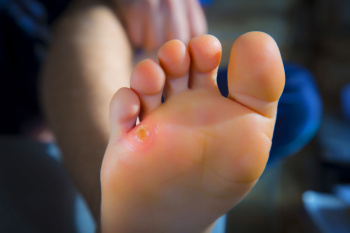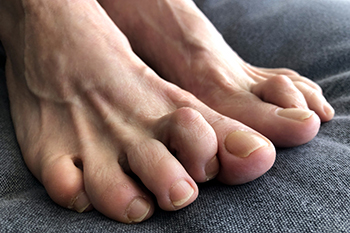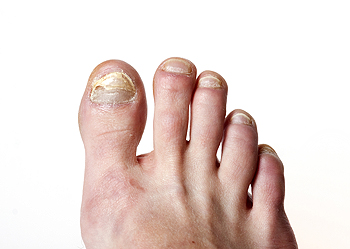Items filtered by date: February 2024
The Importance of Wearing Properly Fitting Shoes

In our modern world dominated by concrete and cement, the demise of shoes seems unlikely. This reliance, however, has led to chronic back and foot pain. Podiatrists play an important role in addressing these issues. Wearing improper or ill-fitting shoes can lead to various problems, from bunions to muscle tension and even plantar fasciitis. Choosing the right shoes involves considering factors like foot swelling throughout the day and ensuring proper fit and support. Additionally, rotating shoes to engage different muscles and replacing worn out ones are important practices. A podiatrist can offer personalized advice and treatments to alleviate foot pain and prevent future issues, emphasizing the importance of footwear in maintaining healthy and pain-free feet. If you would like guidance in making sure you get the right sized shoes that fit your feet well, it is suggested that you schedule an appointment with a podiatrist for a consultation.
Getting the right shoe size is an important part of proper foot health. Seek the assistance of Dr. Thomas E. Silver from Westwood Foot Clinic. Our doctor will provide the care you need to keep you pain-free and on your feet.
Getting the Right Shoe Size
There are many people who wear shoes that are the incorrect size, negatively affecting their feet and posture. Selecting the right shoes is not a difficult process, so long as you keep several things in mind when it comes to choosing the right pair.
- When visiting the shoe store, use the tools available to measure your foot.
- Be sure there is ‘wiggle room’. There should be about an inch between your toes and the tip of your shoes.
- Do not always assume you are the same size, as manufacturers run differently.
- Purchase shoes later in the day, as your feet swell as the day progresses.
- If a shoe is not comfortable, it is not suitable. Most shoes can’t be ‘broken in’, and comfort should be the ultimate goal when it comes to choosing the right pair of shoes
As our feet hold our body weight and keep us moving, it is important to treat them right. Picking the right pair of shoes can provide your feet comfort and mobility without pain.
If you have any questions, please feel free to contact our office located in Golden Valley, MN . We offer the newest diagnostic and treatment technologies for all your foot care needs.
Why Foot Corns Develop in Certain Spots
 Corns can develop on many parts of the feet, although certain areas are more prone to corn formation due to increased pressure, friction, or rubbing against footwear. One common location for corns is on the tops of the toes, particularly over joints where the toe bones meet. The pressure from shoes that are too tight or narrow can cause friction in these areas. Similarly, corns may form on the sides of the toes, where adjacent toes rub against each other or against the sides of shoes. On the soles of the feet, corns often occur over bony prominences, such as the balls of the feet or the heels. Excessive pressure from walking or standing can cause thickened areas of skin to develop. Soft corns can also form between the toes due to moisture accumulation and friction. If you have corns on your feet, it is suggested you consult with a podiatrist who can provide more information about effective treatment and prevention.
Corns can develop on many parts of the feet, although certain areas are more prone to corn formation due to increased pressure, friction, or rubbing against footwear. One common location for corns is on the tops of the toes, particularly over joints where the toe bones meet. The pressure from shoes that are too tight or narrow can cause friction in these areas. Similarly, corns may form on the sides of the toes, where adjacent toes rub against each other or against the sides of shoes. On the soles of the feet, corns often occur over bony prominences, such as the balls of the feet or the heels. Excessive pressure from walking or standing can cause thickened areas of skin to develop. Soft corns can also form between the toes due to moisture accumulation and friction. If you have corns on your feet, it is suggested you consult with a podiatrist who can provide more information about effective treatment and prevention.
Corns can make walking very painful and should be treated immediately. If you have questions regarding your feet and ankles, contact Dr. Thomas E. Silver of Westwood Foot Clinic. Our doctor will treat your foot and ankle needs.
Corns: What Are They? And How Do You Get Rid of Them?
Corns are thickened areas on the skin that can become painful. They are caused by excessive pressure and friction on the skin. Corns press into the deeper layers of the skin and are usually round in shape.
Ways to Prevent Corns
There are many ways to get rid of painful corns such as:
- Wearing properly fitting shoes that have been measured by a professional
- Wearing shoes that are not sharply pointed or have high heels
- Wearing only shoes that offer support
Treating Corns
Although most corns slowly disappear when the friction or pressure stops, this isn’t always the case. Consult with your podiatrist to determine the best treatment option for your case of corns.
If you have any questions please feel free to contact our office located in Golden Valley, MN . We offer the newest diagnostic and treatment technologies for all your foot and ankle needs.
Hammertoe Symptoms

Daily wear and tear can harm your toes, which are essential for balance and movement. Hammertoe is a toe problem where the middle joint bends upward, making the toe look like a hammer. Toes have muscles on top to stretch them and muscles underneath to bend them. Weak bottom muscles can lead to an upward bend at the middle joint, causing a hammertoe. This can hurt while walking and may affect balance. Symptoms include a bent toe that will not relax, swelling, corns, calluses, pain while walking, and changes in balance or walking style. Other toe issues like claw toes, mallet toes, and bunions exist, often alongside hammertoes. Risk factors include foot shape, medical conditions, like diabetes, arthritis, wrong shoes, and foot injuries. If you have a hammertoe that is causing discomfort, it is suggested that you schedule an appointment with a podiatrist for guidance.
Hammertoes can be a painful condition to live with. For more information, contact Dr. Thomas E. Silver of Westwood Foot Clinic. Our doctor will answer any of your foot- and ankle-related questions.
Hammertoe
Hammertoe is a foot deformity that occurs due to an imbalance in the muscles, tendons, or ligaments that normally hold the toe straight. It can be caused by the type of shoes you wear, your foot structure, trauma, and certain disease processes.
Symptoms
- Painful and/or difficult toe movement
- Swelling
- Joint stiffness
- Calluses/Corns
- Physical deformity
Risk Factors
- Age – The risk of hammertoe increases with age
- Sex – Women are more likely to have hammertoe compared to men
- Toe Length – You are more likely to develop hammertoe if your second toe is longer than your big toe
- Certain Diseases – Arthritis and diabetes may make you more likely to develop hammertoe
Treatment
If you have hammertoe, you should change into a more comfortable shoe that provides enough room for your toes. Exercises such as picking up marbles may strengthen and stretch your toe muscles. Nevertheless, it is important to seek assistance from a podiatrist in order to determine the severity of your hammertoe and see which treatment option will work best for you.
If you have any questions, please feel free to contact our office located in Golden Valley, MN . We offer the newest diagnostic and treatment technologies for all your foot care needs.
Symptoms and Prevalence of Toenail Fungus

Toenail fungus, clinically known as onychomycosis, is a common condition that affects a significant portion of the population. This fungal infection typically occurs when microscopic fungi invade the toenails, leading to discoloration, thickening, and crumbling. The warm and moist environment inside shoes provides an ideal breeding ground for these fungi, making toenails susceptible to infection. Symptoms include changes in nail texture and color, ranging from yellowing to darkening. As the infection progresses, nails may become brittle and emit a foul odor. Toenail fungus is more prevalent than one may think, with a considerable percentage of the population grappling with this condition. Recognizing the symptoms early on is essential for effective management, as untreated toenail fungus can lead to persistent discomfort and potential complications. If you have a toenail fungus infection, it is suggested that you visit a podiatrist who can confirm the diagnosis and offer correct treatment methods, which often includes prescribed medication.
If left untreated, toenail fungus may spread to other toenails, skin, or even fingernails. If you suspect you have toenail fungus it is important to seek treatment right away. For more information about treatment, contact Dr. Thomas E. Silver of Westwood Foot Clinic. Our doctor can provide the care you need to keep you pain-free and on your feet.
Symptoms
- Warped or oddly shaped nails
- Yellowish nails
- Loose/separated nail
- Buildup of bits and pieces of nail fragments under the nail
- Brittle, broken, thickened nail
Treatment
If self-care strategies and over-the-counter medications does not help your fungus, your podiatrist may give you a prescription drug instead. Even if you find relief from your toenail fungus symptoms, you may experience a repeat infection in the future.
Prevention
In order to prevent getting toenail fungus in the future, you should always make sure to wash your feet with soap and water. After washing, it is important to dry your feet thoroughly especially in between the toes. When trimming your toenails, be sure to trim straight across instead of in a rounded shape. It is crucial not to cover up discolored nails with nail polish because that will prevent your nail from being able to “breathe”.
In some cases, surgical procedure may be needed to remove the toenail fungus. Consult with your podiatrist about the best treatment options for your case of toenail fungus.
If you have any questions, please feel free to contact our office located in Golden Valley, MN . We offer the newest diagnostic and treatment technologies for all your foot care needs.

